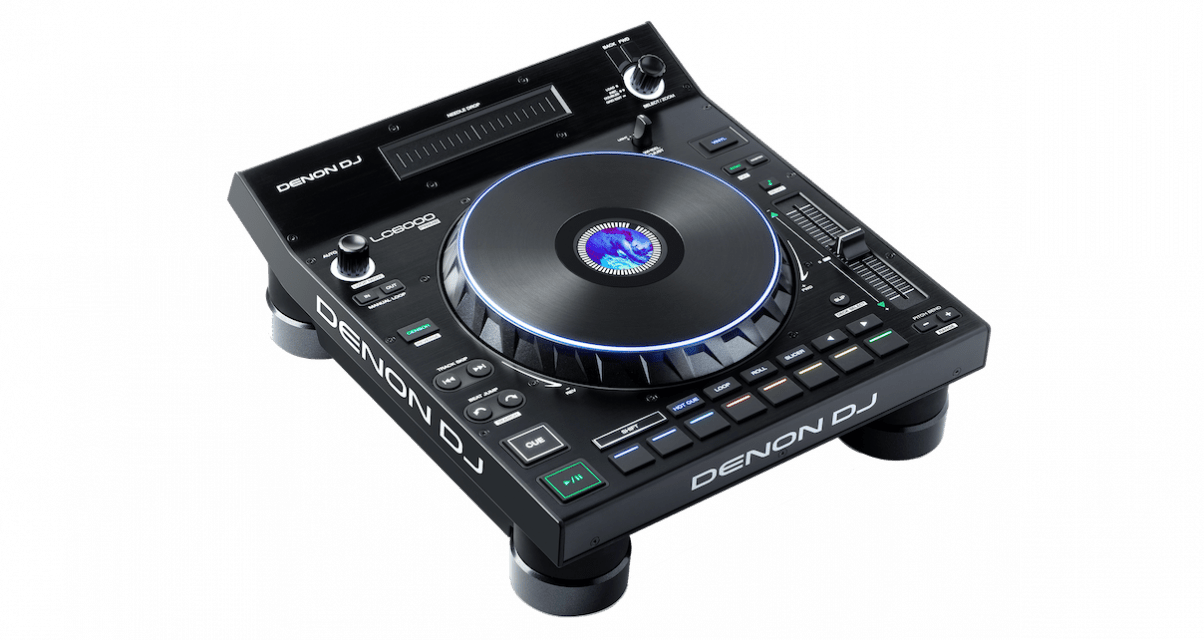The Lowdown
The LC6000 Prime is a unique piece of equipment, being a full-sized, single-deck Midi controller. The deck is brilliantly made and great to use. It fits perfectly alongside the Denon DJ Prime media players, where it gives physical control over one of their built-in two “layers” (decks), but also works well with other software, namely Serato, Virtual DJ, and Algoriddim’s djay Pro AI. It would be good if it could also be used alongside the company’s own Prime 4 controller, and also I think many Traktor software users would love to see this work with their gear, too – let’s hope they can make this happen. Recommended.
Video Review
First Impressions / Setting up
If you’re familiar with Denon DJ’s SC series of media players (the SC5000, SC5000M, SC6000 and SC6000M), this controller will be instantly recognisable to you. It clearly comes from the same stable. It is the same width and height, and curves up at the back like the SC media players. However, as it lacks the screen of those devices, it is not as deep. It sits nicely alongside them.
It has exactly the same control layout – the same 8.5″ jogwheel with central screen, the same layout of eight horizontal rubberised, backlit performance pads underneath the jogwheel, the same layout of loop controls, transport, pitch, library controls and so on. The jogwheel has the same mechanical wheel adjust knob to make the wheel looser or tighter.
All it’s missing, apart from the big touchscreen of course, is the knob for deck slowdown speed – when you’re plugged into Denon DJ’s Prime gear, this setting comes from the primary player (more on how to set these up shortly).
Unlike those players, though, this one has a large “needle drop” touchstrip across the top for quick track navigation (on the primary players, you can do this on the touchscreen).
Learn to DJ with Digital DJ Tips: The Complete DJ Course
It has the same matt plastic sides and underneath as the SC players, and the same black brushed metal top plate. It comes with a power brick to provide it with power should whatever you plug it into not be able to provide enough USB power – we didn’t have to use this in testing.
Let’s first look at all the ways you could potentially use it, then cover off the two main ones:
Using with Denon DJ Prime gear
You put your LC6000 Prime into position, plug the supplied USB cable from the back of it into one of the USB sockets on the back of your SC player, and turn the LC6000 on. The LC6000 is then instantly recognised by the SC player, and the touchscreen of the SC player now displays two large parallel waveforms, the lower of which corresponds with whatever you load onto the LC6000.
Need help understanding all of this?
Completely lost about controllers, decks, mixers, and all the rest of the gear needed for DJing? Grab a free copy of our beginners book, Rock The Dancefloor!, when you join Digital DJ Tips today – it’s free and instant. Click here to become our latest member.
To hear the music it controls, you plug an extra set of RCA cables (or a digital cable) from the second “layer” output on the back of the paired SC player into a spare channel on your mixer – just the same as you would anyway if you wanted to use both “layers” on the SC player without an extra physical unit. All you’re getting extra here is separate control over that extra layer. Be clear that there are no audio outputs on the LC6000.
Using with DJ software
This currently works with Serato DJ Pro, Algoriddim’s djay Pro AI, and Virtual DJ. We tested it with Serato DJ Pro – it will be similar with the other software too.
To use it with DJ software, you plug a USB cable from the LC6000 into the laptop running your software. If you’re using a mixer and decks, that equipment may have a built-in USB hub that you can use, but as long as there is a USB link between the laptop and the LC6000, Serato will “see” it.
Once you’ve done this, the first four performance pads light up in blue. This is for you to choose which deck will be controlled by the LC6000. You tap the deck you want to control, and it springs into life – you’re ready to go.
In Use
Because the Denon DJ LC6000 has the familiar look and feel from Denon DJ’s media players, thats exactly what it feels like in use. The central displays give you the same info, the jogwheel feels the same. It’s just great to have an actual physical deck for the second layer on the player you pair it with.
Really, a Denon DJ set-up of, say, two SC6000 players, two LC6000 sub-controllers, and an X1850 mixer, is Denon DJ’s more cost-effective equivalent to a Pioneer DJ set-up of four CDJ-3000s and a DJM-900NXS2 mixer. The only compromise you’re making is having two screens instead of four.
In use, that doesn’t feel like an imposition and doesn’t impede your DJing – the way Denon DJ has incorporated the dual-layer waveforms makes it easy to DJ on, and the library browse feature works just as well “borrowing” the screen from the primary unit when needed.
The only thing we noticed (and it is a very small thing) is that the buttons on the LC6000 are just very slightly different in feel to the SC6000 we had it alongside. They are more clicky and less spongy than on the SC6000s. They’re no better or worse – just a bit different. I doubt you’d notice and even if you did, it will be unlikely to annoy you.
Using with Serato
When it comes to using with Serato, we set this up with a Pioneer DJ DDJ-1000SRT, although to be clear: These will work with any controller that works with the four-deck version of Serato (you’ll want one with a four-channel mixing section, too).
An interesting thing to note is that you could pair four of these with a Serato-compatible DJ mixer, and build a relatively cheap full-sized Serato DJ system that way. All you’d need would be a powered four-way USB hub, presuming you don’t have four spare USBs on your laptop (and to keep things tidy, even if you do).
Learn to DJ with Digital DJ Tips: The Complete DJ Course
You get pretty decent control over the software, although not perfect. The jogs are tight and responsive, so no performance issues, but the display doesn’t show you much info (just a deck colour ring and the rotation graphic). All controls do what they should, though, including the library controls and looping.
The pads give you control over hot cues, auto loop, manual loop, loop roll, slicer, slicer loop, and Pitch Play.
We didn’t test with Algoriddim’s djay Pro AI or Virtual DJ, but we’d expect a similar level of performance and control.
Conclusion
The Denon DL LC6000 Prime fills a gap in the market. There is no full-sized deck-only controller available from anyone else.
For Denon DJ’s own Prime gear it is a genius move. Buy a pair of SC6000 Primes for $1600 each, two LC6000 Primes at $700 each, and an X1850 Prime mixer for $1200, and for $5,800 you have a full-sized, pro four-deck DJ set-up.
To do this with Pioneer DJ’s gear would cost you $2,300 for each of four CDJ-3000 media players, and $2,200 for a DJM-900NXS2 mixer, or $11,400 in total – basically twice the price.
Now, say what you want about Pioneer DJ being the club standard (it is), that is still a $5,600 difference in price, and right now the Denon Prime gear does more stuff than the Pioneer gear, too.
Plus, you could buy a single SC6000 Prime and a single LC6000 Prime plus a mixer and be up and running, again at a fraction of the cost you’d spend to do the same with Pioneer DJ gear – just $3,500.
The LC6000s will, we predict, make more people take a closer look at the Denon DJ Prime pro solution than may have done before, simply because of this huge cost difference.
But the fact that it works with Serato, Virtual DJ and djay Pro AI too suddenly gives users of those platforms options for adding a third or a third and fourth deck to their DJing, too.
Learn to DJ with Digital DJ Tips: The Complete DJ Course
To have an extra deck for dropping acapellas, DJ idents, or those complex transitions where it just gets all too fiddly on a four-channel but two-deck DJ controller, the LC6000 fits the bill perfectly, even if it is a bit big to sit next to most controllers.
Of course it doesn’t work with Pioneer DJ’s Rekordbox DJ software (and almost certainly never will), but we would like to see it work with Traktor – a pair of these alongside a Traktor Kontrol Z2 or indeed any Traktor-compatible DJ mixer would be a breath of fresh air for users of that platform. Let’s hope they get that sorted out – it would be a win/win for everyone.
Also, it doesn’t work with Denon DJ’s Prime 4, which I think is a bit of a surprise – it would be great to use these to “unlock” the extra decks on the Prime 4, and I don’t see any reason why it couldn’t or shouldn’t. Again, hopefully this will happen soon.
Read this next: 5 Best DJ Controllers Over $1000
To sum up: The LC6000 Prime is a simple but good idea, filling a definite gap in the market, and it’s been well executed. Denon DJ continues to innovate. Recommended.


